Post by FMW on Aug 12, 2014 11:18:29 GMT -8
Subtitle: Frankenstein Research Center Report - 08/12/14
The Project - cast some big, fat, well-treaded pro-street tires & wheels.
The Experiment - cast the tires in soft rubber-like resin.
The Challenge - cast the wheels in hard resin inside the tires using a single mold.
I'd been thinking about this project for some time. I started it in November of 2011 by ordering the following from Micro-Mark:
1 82057 CR-600 Casting Resin, 32 fl. oz.
1 82135 Black Opaque Pigment, 1 oz.
1 82987 TCR-40 Tire Casting Rubber, 2 lbs.
(Yeah, 2011. I don't work real fast.)
I bought the following in January (my old stuff having gone bad).
1 80475 Rubber-to-Rubber Mold Release, 2 fl. oz.
1 82083 One-To-One / Rapid Mold Rubber, 32 fl. oz.
I pulled the rear tires and rims from Revell's 7189 Pro-Street T-Bird because they were a good example of what I wanted.
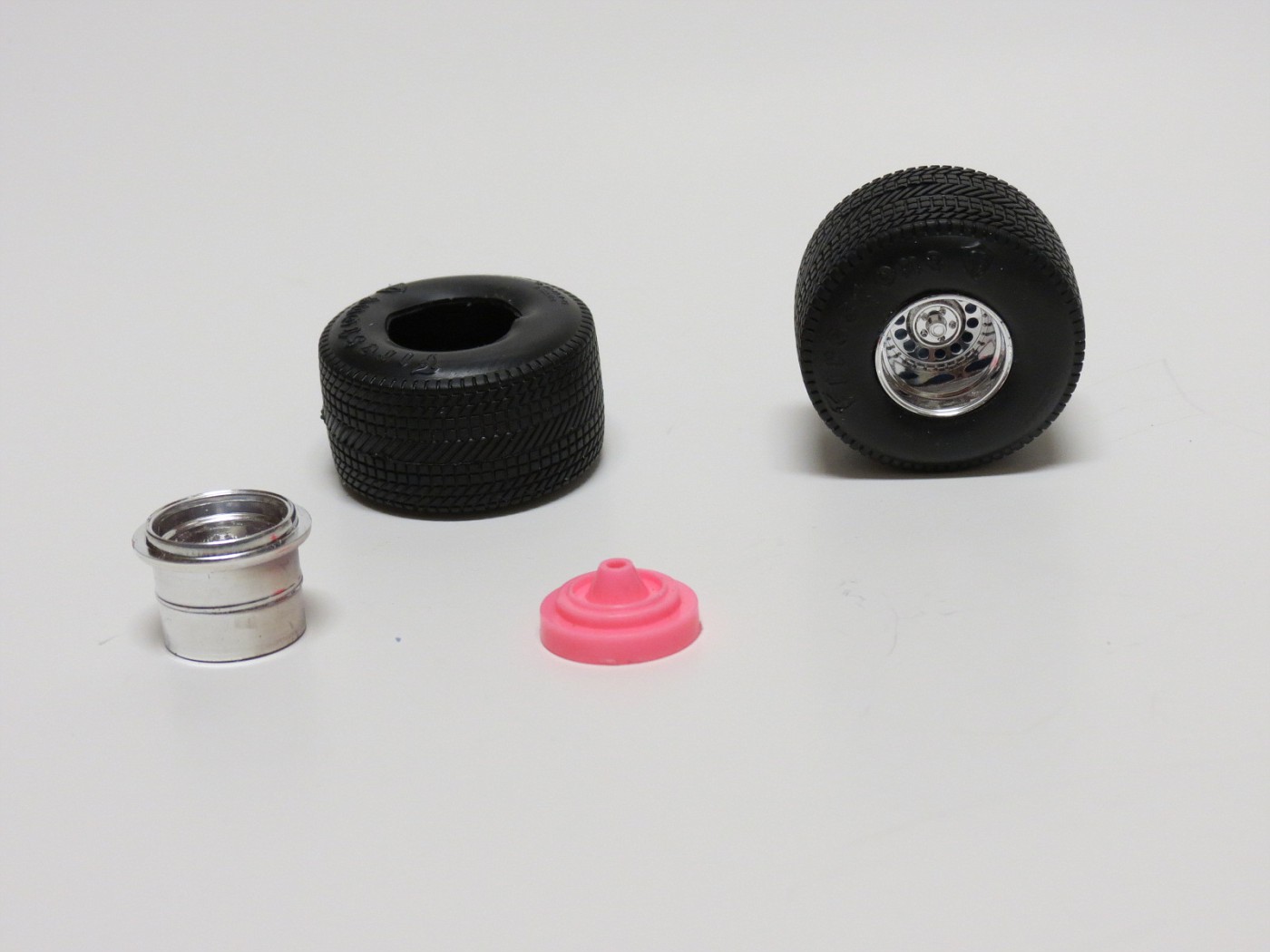
I assembled the tires and rims (press-fit) and produced a 2-piece mold. I then created a pair of cylindrical, stepped inserts to separate the tire area from the wheel area.

Now is where things got interesting ("interesting" does not equal "good".)
The Tire Casting Rubber came in opaque white bottles, sealed inside by not-easily-removed blue plastic plugs. One part was the consistency of honey, the other part was like slightly used motor oil (look, color, and feel). This was my first "Ewww" moment. I poured out equal amounts into two small measuring cups. I then got the pigment. The instructions warned to use a small amount, as the chemical could inhibit the setting of the rubber. Opening the 3 year old bottle for the first time if found that shelf life had gotten to me - it was like a blob of cold tar. I extracted some as well as I could with a Q-tip and mixed it with the oily component of the rubber. I used as much as I dared, and still didn't get anything close to black. I mixed the components and poured them into the mold. My inserts, which had just been set in place, showed a marked tendency to float. I pushed them back down and poured the mix as carefully as I could, but still got leakage. I used the top of the mold to cast the back sides of the tires. Since this was a first attempt, I hadn't compromised the mold to allow the inserts to project through. When the resin had set, I removed the inserts. I had coated their outer sides with mold release, so even with the leakage they came out without too much effort. (The leakage had solidified into plugs that I may use as sealing rings if I ever try this again - not likely.) I mixed and poured the solid resin into the hole left in the center of the tires. The result is shone here:

As seen, I had achieved a rather slug-like color, which matched the feel of the compound. Where the dye hadn't dissolved, it created sticky pits in the surface. Also, some of the leaked rubber still remained in the wheel area of the mold.
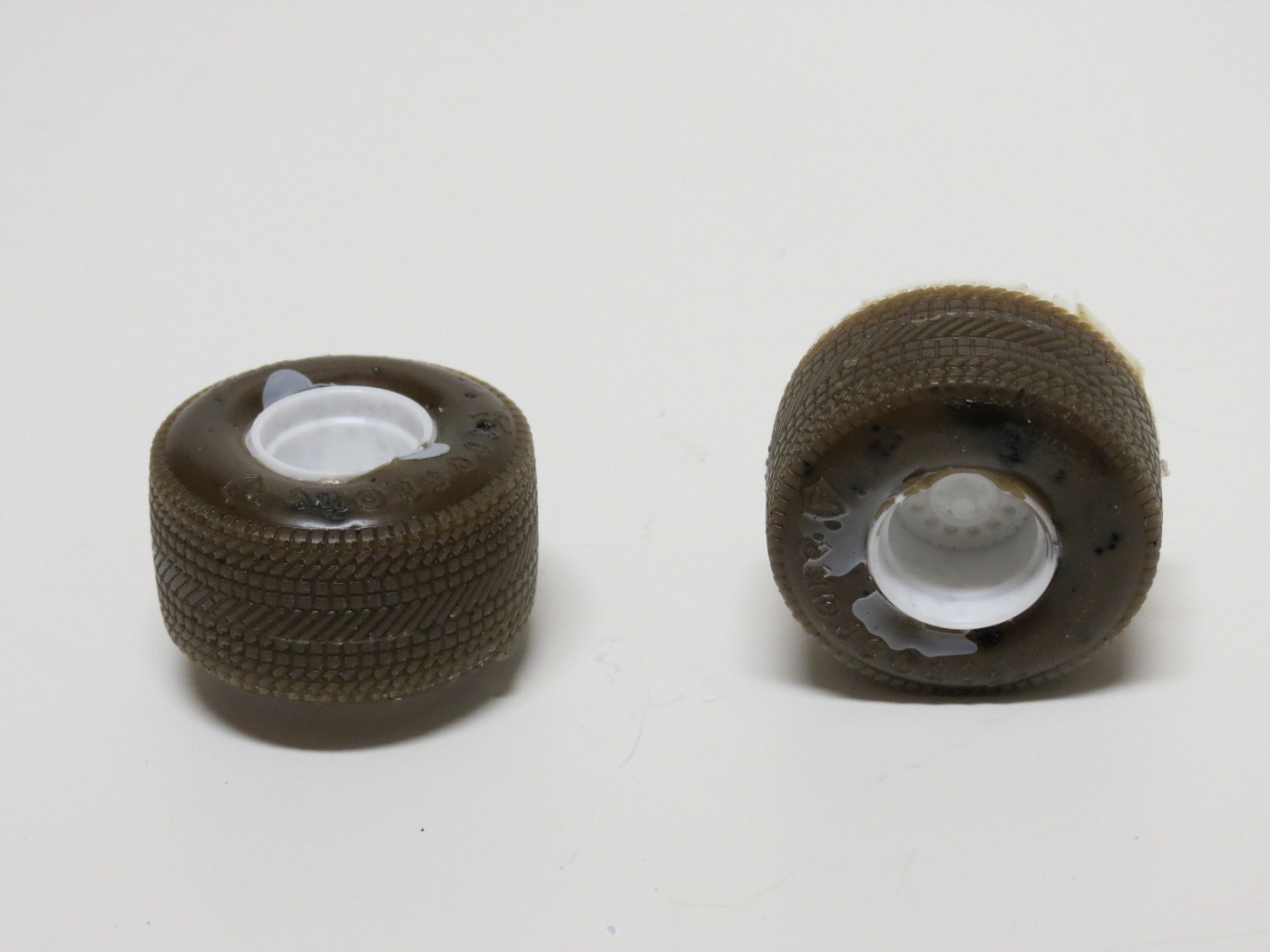
Fortunately the mold had survived all of this. I used it to cast a set of hard-resin wheel/tire pairs.
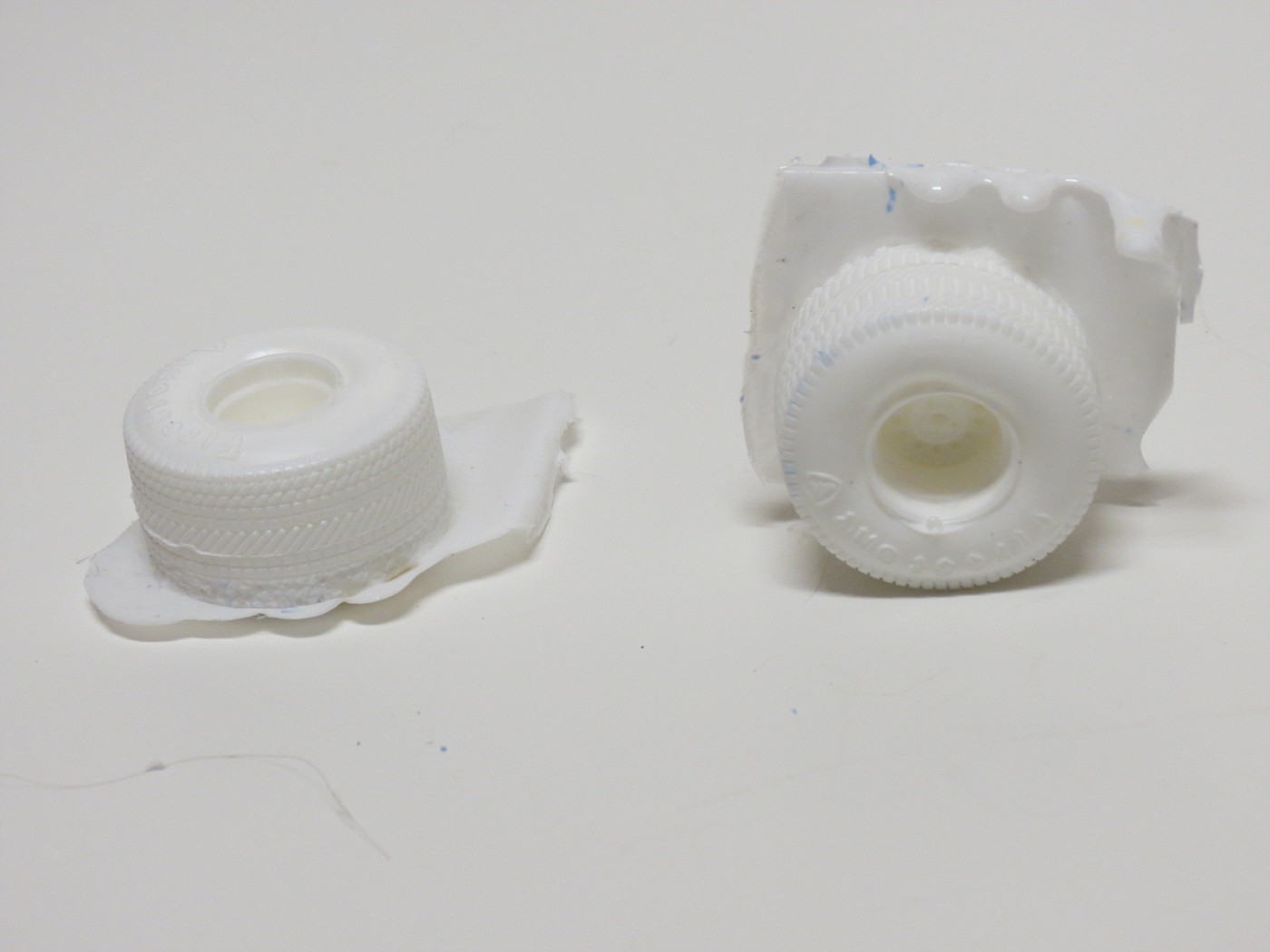
Here is a comparison photo of the two tires.
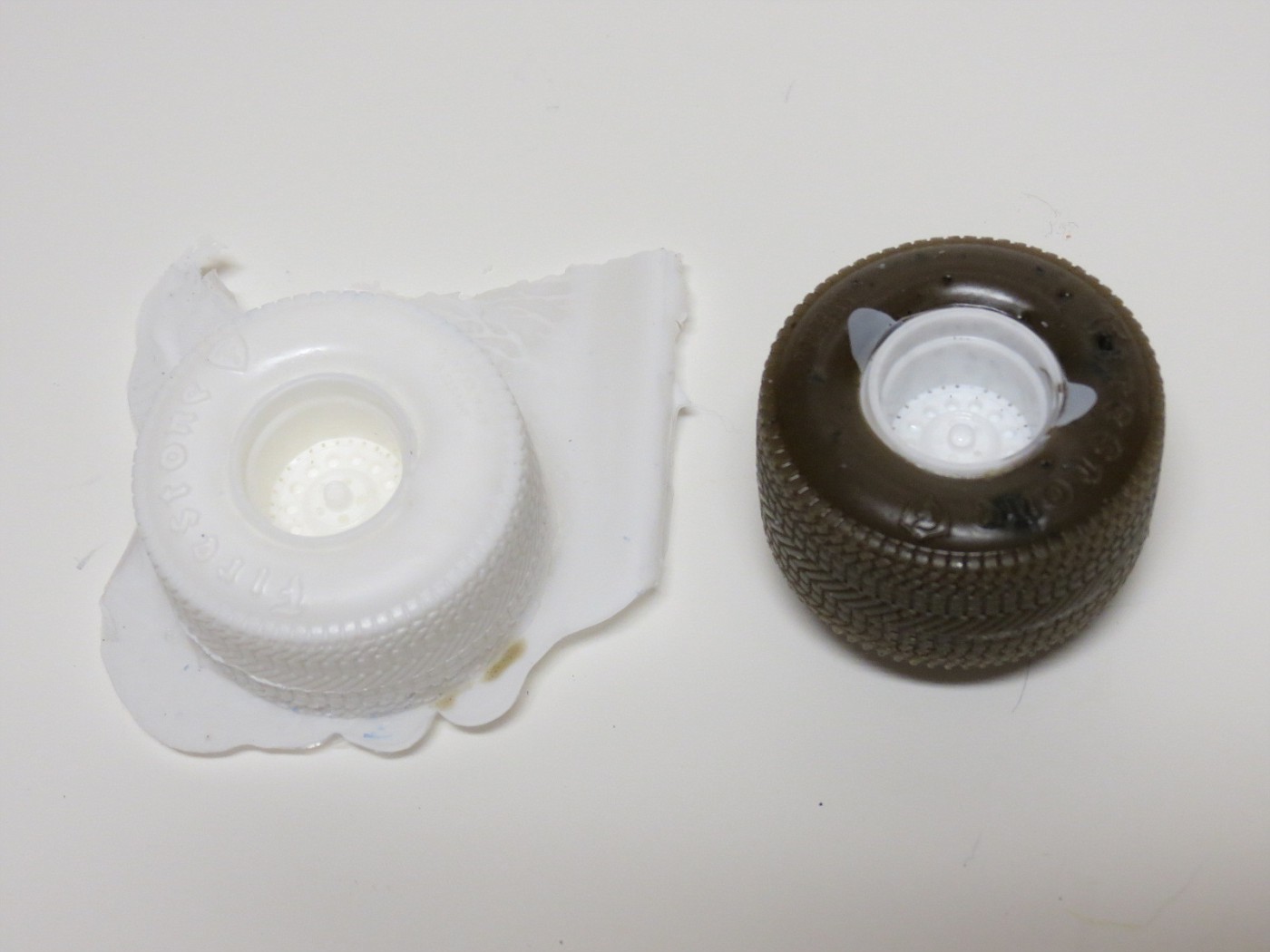
As part of the experiment, I colored a portion of each tire with a black Sharpie marker. I cleaned the dye out of the soft tire with alcohol. The dye proved to be very alcohol soluble. The tire felt kind of stickier for a while after, so they may be slightly soluble as well. Possibly because of this, the soft tires accepted the Sharpie ink very well, much better than the hard tire.
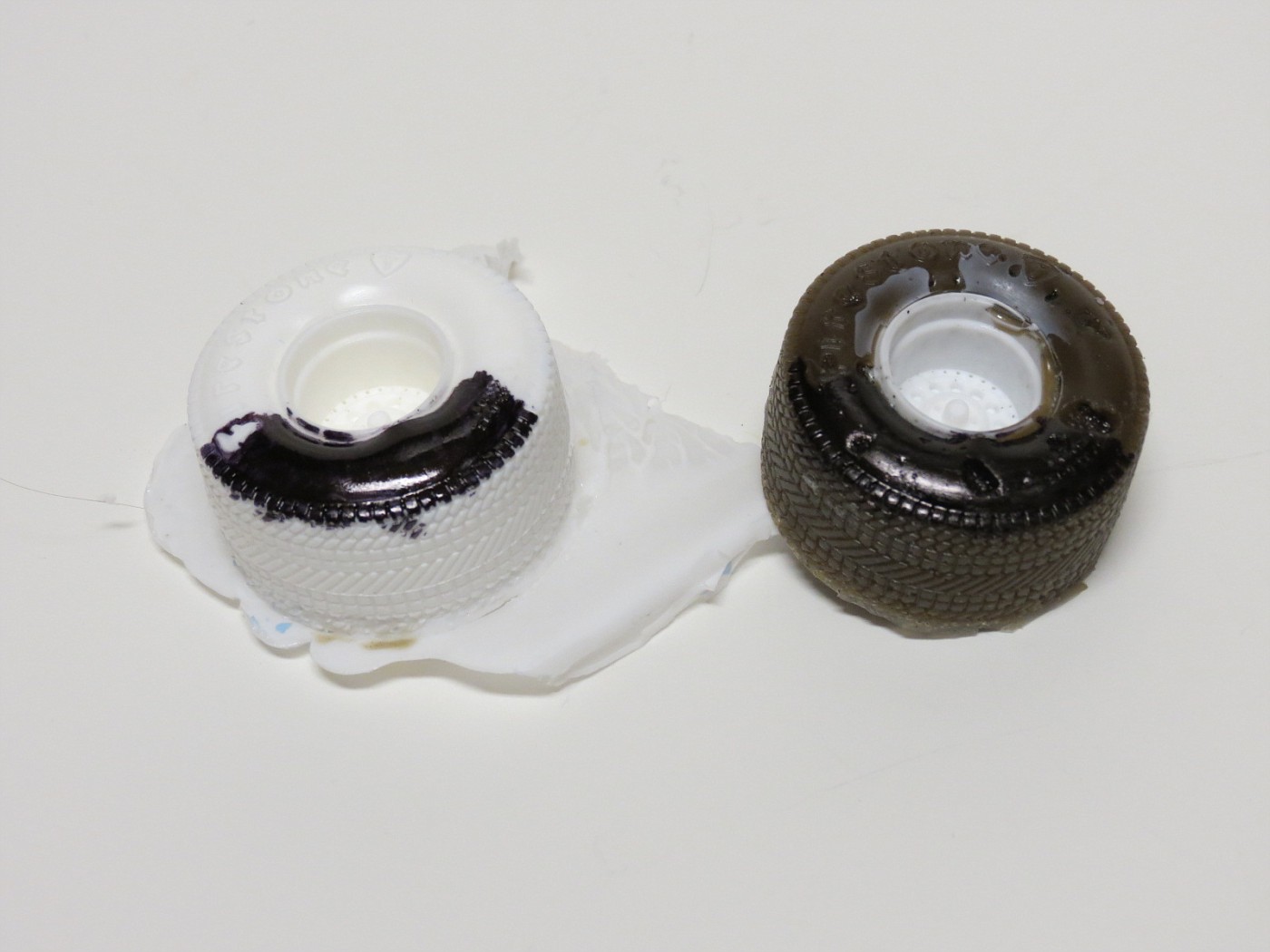
I used my Paintshop Pro program to place the colored sections of the tires in close visual proximity for a better comparison.
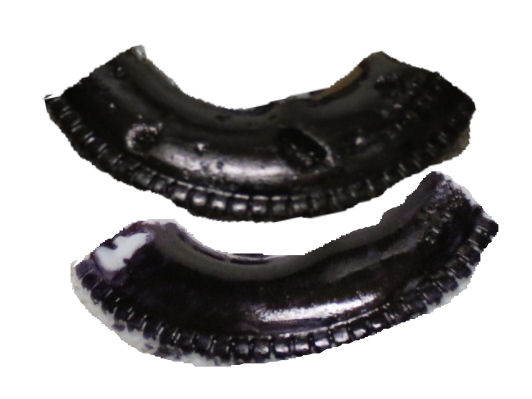
Conclusion 1 - Casting hard resin pieces and soft resin pieces in the same mold is feasible, with proper preparation and adequate separator sealing.
Conclusion 2 - Evaluation of the performance of the Micro-Mark casting rubber and dye combination is not valid because of the self-life issue. However, because of the weak effect of the dye that was used, achieving adequate color density is suspect.
Conclusion 3 - For me, messing around with the tire casting rubber just to produce a squishy tire is not worth the effort. Unless you're going to load all of the hidden inner space of the model with tungsten weights, you're not going to achieve any noticeable deformation or great visual difference.
A note for any of you who might be planning amateur casting - always wear gloves (I use the Curad vinyl gloves) and have plenty of paper towels pre-separated and within reach.
FMW
P.S. I just noticed I was post #666 in resin casting. How appropriate.
FMW
The Project - cast some big, fat, well-treaded pro-street tires & wheels.
The Experiment - cast the tires in soft rubber-like resin.
The Challenge - cast the wheels in hard resin inside the tires using a single mold.
I'd been thinking about this project for some time. I started it in November of 2011 by ordering the following from Micro-Mark:
1 82057 CR-600 Casting Resin, 32 fl. oz.
1 82135 Black Opaque Pigment, 1 oz.
1 82987 TCR-40 Tire Casting Rubber, 2 lbs.
(Yeah, 2011. I don't work real fast.)
I bought the following in January (my old stuff having gone bad).
1 80475 Rubber-to-Rubber Mold Release, 2 fl. oz.
1 82083 One-To-One / Rapid Mold Rubber, 32 fl. oz.
I pulled the rear tires and rims from Revell's 7189 Pro-Street T-Bird because they were a good example of what I wanted.

I assembled the tires and rims (press-fit) and produced a 2-piece mold. I then created a pair of cylindrical, stepped inserts to separate the tire area from the wheel area.

Now is where things got interesting ("interesting" does not equal "good".)
The Tire Casting Rubber came in opaque white bottles, sealed inside by not-easily-removed blue plastic plugs. One part was the consistency of honey, the other part was like slightly used motor oil (look, color, and feel). This was my first "Ewww" moment. I poured out equal amounts into two small measuring cups. I then got the pigment. The instructions warned to use a small amount, as the chemical could inhibit the setting of the rubber. Opening the 3 year old bottle for the first time if found that shelf life had gotten to me - it was like a blob of cold tar. I extracted some as well as I could with a Q-tip and mixed it with the oily component of the rubber. I used as much as I dared, and still didn't get anything close to black. I mixed the components and poured them into the mold. My inserts, which had just been set in place, showed a marked tendency to float. I pushed them back down and poured the mix as carefully as I could, but still got leakage. I used the top of the mold to cast the back sides of the tires. Since this was a first attempt, I hadn't compromised the mold to allow the inserts to project through. When the resin had set, I removed the inserts. I had coated their outer sides with mold release, so even with the leakage they came out without too much effort. (The leakage had solidified into plugs that I may use as sealing rings if I ever try this again - not likely.) I mixed and poured the solid resin into the hole left in the center of the tires. The result is shone here:

As seen, I had achieved a rather slug-like color, which matched the feel of the compound. Where the dye hadn't dissolved, it created sticky pits in the surface. Also, some of the leaked rubber still remained in the wheel area of the mold.

Fortunately the mold had survived all of this. I used it to cast a set of hard-resin wheel/tire pairs.

Here is a comparison photo of the two tires.

As part of the experiment, I colored a portion of each tire with a black Sharpie marker. I cleaned the dye out of the soft tire with alcohol. The dye proved to be very alcohol soluble. The tire felt kind of stickier for a while after, so they may be slightly soluble as well. Possibly because of this, the soft tires accepted the Sharpie ink very well, much better than the hard tire.

I used my Paintshop Pro program to place the colored sections of the tires in close visual proximity for a better comparison.

Conclusion 1 - Casting hard resin pieces and soft resin pieces in the same mold is feasible, with proper preparation and adequate separator sealing.
Conclusion 2 - Evaluation of the performance of the Micro-Mark casting rubber and dye combination is not valid because of the self-life issue. However, because of the weak effect of the dye that was used, achieving adequate color density is suspect.
Conclusion 3 - For me, messing around with the tire casting rubber just to produce a squishy tire is not worth the effort. Unless you're going to load all of the hidden inner space of the model with tungsten weights, you're not going to achieve any noticeable deformation or great visual difference.
A note for any of you who might be planning amateur casting - always wear gloves (I use the Curad vinyl gloves) and have plenty of paper towels pre-separated and within reach.
FMW
P.S. I just noticed I was post #666 in resin casting. How appropriate.
FMW

